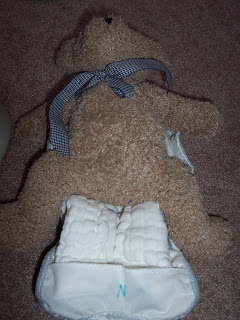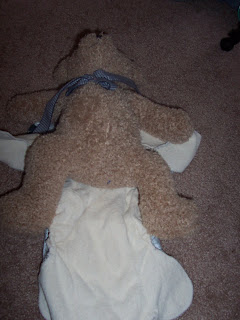For the poo-pockets, I wrap the diaper around the baby (or teddy bear for pictures as my baby doesn't hold still), and then wrap the cover on top. Very easy and quick.
Step 1: Lay out the diaper cover and place the diaper on the cover. Lay the baby on top of the diaper.

Step 3: Wrap the cover over the diaper and around the baby and over the diaper.
For the pre-fold diapers lay the diaper in the cover and put it on like a disposable by wrapping it around the baby and then securing it with the aplix (velcro-like) fasteners.


I put used diapers in an orange bucket that I got at Home Depot. This is called the dry pail method. While a baby is only breastfed, the diapers do not even need to be rinsed first.
Once my baby started solids, I needed to start rinsing his bowel movements out of the diapers. This is very easy with a toilet sprayer and potty pail. The sprayer attaches to the toilet. The pail has a hole in the bottom and sits on top. I spray the diaper in the pail and it goes right into the toilet to flush away. It really is quick and easy.
Then, I wash diapers every other day. I just put the diapers from the orange bucket into the washing machine. I run a normal cycle in hot water with Allen's detergent (you will want to buy special detergent that won't build up and reduce absorbency in your diapers), I also add in a pre-wash and an extra rinse.
For drying the diapers, I do the shortest cycle on the dryer and use dryer balls (fabric softener is not recommended as it can reduce diaper absorbency). Then I hang the diapers on a drying rack to finish drying. You can dry them completely in the dryer. I prefer the short cycle (to soften the diapers) and then air dry on the racks.









